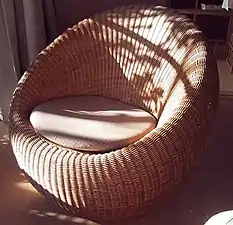Isamu Kenmochi | |
|---|---|
剣持勇 | |
| Born | 2 January 1912 |
| Died | 3 June 1971 (aged 59) Shinjuku, Tokyo |
| Education | Chiba University |
| Awards | G-Mark Prize Mainichi Design Prize |

Isamu Kenmochi (Japanese: 剣持勇, 1912 - 1971) was a Japanese modernist designer significant in the development of Japanese industrial design after World War II.[1]
Isamu Kenmochi was born on 2 January 1912 in Tokyo.[2] Kenmochi graduated from the Tokyo College of Industrial Arts (Japanese: 東京高等工芸学校, now Chiba University Faculty of Engineering) in 1932. After his graduation, Kenmochi worked at the Industrial Arts Research Institute in Tokyo.[1]
Kenmochi met artist and designer Isamu Noguchi in the summer of 1950 on Noguchi's first trip to Japan.[3] Together, the two developed a number of furniture designs, pioneering the Japanese Modern style which integrated the material culture of Japanese furniture with modernist styles.[4][5]
In 1952, Kenmochi visited the United States, later writing about the visit in the Industrial Arts Research Institute's publication, Kogei Nyusu.[6] Later that year, Kenmochi became a founding member of the Japan Industrial Designers Association.[1]

In 1964, Kenmochi's 1958 design for a lounge chair commissioned by the Yamakawa Rattan Company was added to the design collection of the MoMA. The design additionally won the G-Mark Prize (Good Design Selection System).[1]
Kenmochi committed suicide on 3 June 1971 in Shinjuku, Tokyo.[2]
References
- 1 2 3 4 "Isamu Kenmochi - Oxford Reference". www.oxfordreference.com. Retrieved 2019-03-06.
- 1 2 "剣持勇 :: 東文研アーカイブデータベース". www.tobunken.go.jp. Retrieved 2019-03-06.
- ↑ Schwendener, Martha (2007-09-24). "Design: Isamu Noguchi and Isamu Kenmochi - Art - Review". The New York Times. ISSN 0362-4331. Retrieved 2019-03-06.
- ↑ "Japanese industrial design history: When Isamu met Isamu". Core77. Retrieved 2019-03-06.
- ↑ "design: isamu noguchi and isamu kenmochi". designboom | architecture & design magazine. 2007-10-21. Retrieved 2019-03-06.
- ↑ "Kogei Nyusu - Oxford Reference". www.oxfordreference.com. Retrieved 2019-03-06.